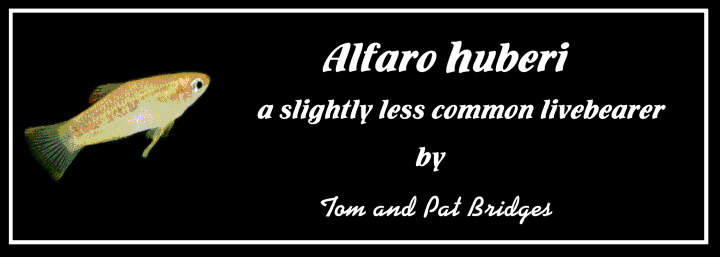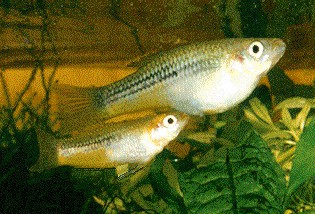

A young pair of A. huberi
This male doesn't like a bare tank
Mother trying to get some peace
2 to 3 week old baby huberi
Juvenile huberi on their own |
Even publications like the "Atlas of Livebearers of the World" © 1993 state that this fish "hasn't caught on yet as an aquarium fish", so I guess it's not surprising that we weren't aware of them until Brian Glazier brought a pair to our club to help illustrate his talk on livebearing fish. We had some success with Alfaro cultratus, (the Knife-edged livebearer), a few years back but here was a new, (to us), species with a similar, (although less pronounced), row of knife-like scales along its bottom edge between the anal fin and the tail. As well, these huberi were chubbier and somewhat more colourful than the cultratus. The scales on the upper body were edged in black and the back lower half of each fish was a golden-yellow. This is a double patronym fish. The genus was named in honour of the zoologist Dr. Anastasio Alfaro of the National Museum in Costa Rica and the species name honours a Dr. Huber. The fish was first described by Fowler in 1923. He placed them in the genus Priapichthys. Later Hubbs revised them to Furcipenis based on the form of the gonopodium and finally Rose and Bailey firmly planted them in the genus Alfaro where they have stayed since 1963. (Isn't nomenclature fun!) Apparently they are found in clear, unpolluted streams along the Altantic side of the Central American countries; Honduras, Nicaragua and Guatemala. The books suggest that they grow to about 5 cm (males) and 7 cm (females). So far our pair is a bit smaller than that but they are still quite young. We acquired the pair at our club auction, brought them home and quickly learned the first hard lesson about these huberi. I decided to acclimatize them to our water in a bucket while I got a tank ready. It was late so they were left overnight in about a half bucket of water with a box filter. The bucket was not securely covered. In the morning the male was happily swimming in the bucket but the female was located some distance away, not yet completely dry, but unable to recover. She probably jumped when the light went on. (If the male had jumped we might still have had some babies to work with but ... such is luck.) Then Pat informed me that Susan Glazier had told her the huberi were good jumpers. The second lesson came when Brian graciously agreed to provide another female. It sure looked like a female but after a couple of weeks in our tank it developed a gonopodium. Now we had two males. Huberi may delay developing male characteristics. I had noted that Brian had far more males than females and I was not about to ask him to part with any more of his huberi. Kitchener saved the day with their special event and rare fish auction. The Glazier's contributed another pair of huberi and our bid was successful. Needless to say, we placed this pair in a well planted and well covered ten gallon tank. A teaspoon of coarse salt was added per gallon of water and a variety of freeze-dried, flake and live (daphnia) foods were fed. So far we've had four small spawns, the largest of which was only a dozen. It is possible that father may have reduced the numbers. We notice that as mother's time to drop approaches he positions himself below and to the rear but we have never actually seen him eat one. The time between spawns has been about 5 weeks. The babies have been healthy and ready to take finely powdered food right from the start. They are a little bigger than the usual guppy fry and don't seem as sensitive as the literature would have us believe. Maybe we've just been lucky. With regular weekly water changes growth has been fairly rapid and some have already been transferred from a mesh net box in the parents' tank to their own ten gallon setup.
So far we have found the Alfaro huberi to be a
somewhat shy but quietly attractive little fish
that doesn't seem likely to over- populate a tank.
(I doubt that they will be sold as feeders any
time soon.) Experiments will have to be done to
see whether they make good community tank
partners with such other livebearers as guppies,
platies and swordtails. We recommend them for
anyone who would like to try something a little
bit different. |